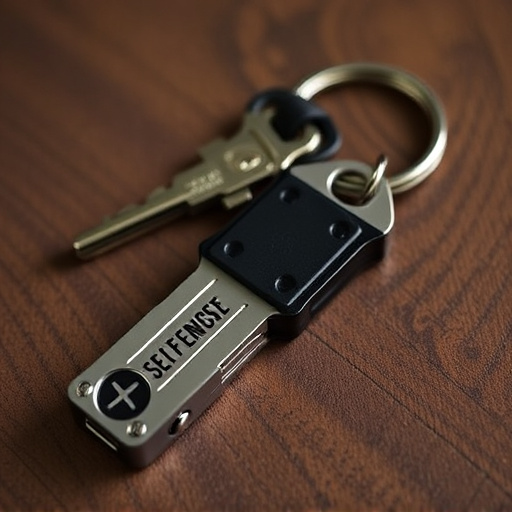Selecting the best metal for a keychain defense tool involves balancing strength, durability, functionality, and legality. High-carbon steel offers superior power but needs more maintenance, while aluminum is lightweight and corrosion-resistant. Stainless steel and titanium are popular choices for their strength and resistance to rust, suitable for various environments and legal for self-defense when used responsibly according to local regulations. The design should prioritize grip, ergonomics, and compliance to create an effective yet legal keychain defense tool.
“Elevate your personal defense with the strategic design of metal keychain grip tools. This comprehensive guide explores the art of creating functional, legal, and safe self-defense devices. From selecting robust metals that withstand daily wear to designing ergonomic grips for comfortable carrying, each aspect matters. Learn about popular metals, grip innovations, effective edge designs, and navigating legal restrictions on sharp edges. Discover best practices for user safety and compliance, ensuring your metal keychain defense tool is both reliable and legally sound.”
- Choosing the Right Metal for Your Keychain Defense Tool
- – Considerations for durability, strength, and legal restrictions
- – Popular metals and their unique properties
- Designing for Grip and Ergonomics
Choosing the Right Metal for Your Keychain Defense Tool
When crafting a metal keychain defense tool, selecting the appropriate material is paramount to its effectiveness and legal compliance. Different metals offer unique properties, each with advantages and disadvantages for self-defense applications. For instance, high-carbon steel is renowned for its strength and edge retention, making it ideal for quick, powerful strikes. However, it may require more maintenance compared to other options.
Aluminum, on the other hand, offers excellent corrosion resistance and a lightweight design, suitable for those seeking a more portable defense option. While not as strong as steel, aluminum keychains can still pack a punch and provide a legal, discreet self-defense solution. Consider your needs, usage frequency, and local regulations when choosing a metal to ensure your keychain defense tool is both effective and legally permissible.
– Considerations for durability, strength, and legal restrictions
When designing a metal defense keychain grip, it’s imperative to balance durability, strength, and functionality while staying within legal constraints. Durability is key; the keychain should withstand frequent use and endure various environmental conditions. High-quality materials like robust steel alloys are essential for longevity. Strength is equally vital to ensure the keychain can effectively defend against potential threats. However, it’s crucial to design with a safe and responsible approach, adhering to legal restrictions governing the use of defense tools in your region.
Legal considerations cannot be overlooked. Different jurisdictions have distinct laws regarding the carrying and use of personal defense tools like keychains. Familiarize yourself with local regulations to ensure your design avoids any potential legal issues. Features such as a simple, non-intrusive design and limited weapon reach can help make your keychain more legally sound. Prioritizing these factors will result in a metal defense keychain grip that is both effective and compliant.
– Popular metals and their unique properties
When designing a metal keychain defense tool, understanding the unique properties of different metals is crucial for functionality and legal considerations. Popular choices include stainless steel and titanium due to their exceptional strength-to-weight ratios. Stainless steel, in particular, offers excellent corrosion resistance, making it ideal for outdoor or wet environments. Its durability ensures that the keychain can withstand regular use without compromising structural integrity.
Titanium, on the other hand, boasts an impressive hardness and low density, providing superior grip and minimal fatigue during extended use. This metal is particularly appealing for tactical applications due to its ability to retain a sharp edge, enhancing cutting capabilities. Both metals are legal for self-defense tools when used responsibly, ensuring that your keychain design adheres to local regulations regarding blade length and overall dimensions.
Designing for Grip and Ergonomics
When designing a metal keychain defense tool, grip and ergonomics are key considerations. The primary goal is to ensure the user can effortlessly grasp and control the device, especially in stressful situations where quick, precise movements are essential. Incorporating ergonomic design principles helps to reduce strain on the user’s hand and wrist during deployment, making it a legal and practical choice for self-defense.
A well-designed keychain defense tool should feature a comfortable grip that allows for a secure, non-slip hold. This can be achieved through textured surfaces, contoured shapes, or the use of ergonomic materials that provide a firm yet flexible grasp. Additionally, the weight distribution and balance of the device should be optimized to ensure it feels natural in the hand, facilitating smooth and efficient movements during use, thus enhancing its effectiveness as a legal self-defense tool.
When designing a metal keychain defense tool, it’s crucial to balance durability, strength, and legal considerations. Choosing the right metal, such as stainless steel or titanium, ensures both longevity and compliance with local laws. Prioritizing grip and ergonomics enhances usability, making your self-defense keychain not just functional but also comfortable to carry. Remember, a well-designed metal keychain defense tool is a practical and legal way to protect yourself in unexpected situations.
